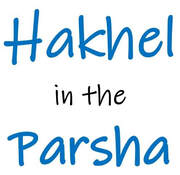In Parshas Behaalosecha we read about Hashem’s command to Moshe to make two silver trumpets. These trumpets were used to call the people together to assemble.
The Tosefta teaches that on the day of Hakhel, the Kohanim would go out into the courtyards and streets of Yerushalaim and blow golden trumpets to gather the people to the Hakhel assembly.
The Torah refers to the two trumpets as שתי חצוצרות. The Maggid of Mezritch teaches that the word שתי חצוצרות (two trumpets) can be read as חצאי צורות, two half forms. This refers to Hashem and the Neshama of the Jew which metaphorically are like two halves of a whole.
The inner message of the trumpet blowing at Hakhel was to call out and reveal to the Jewish people that they are …
At Har Sinai Hashem declared that we are all part of a kingdom of Kohanim. During Hakhel, the Rebbe requested that we gather Jews together in the spirit of Hakhel; to inspire them in the fear of Heaven and the observance of Torah and Mitzvos.
The trumpets of the Kohanim embody the message that will inspire and draw Jews closer; to reveal to each Jew that they are half of a form and that Hashem is their other “Half” and when they are united together they are whole.
The Tosefta teaches that on the day of Hakhel, the Kohanim would go out into the courtyards and streets of Yerushalaim and blow golden trumpets to gather the people to the Hakhel assembly.
The Torah refers to the two trumpets as שתי חצוצרות. The Maggid of Mezritch teaches that the word שתי חצוצרות (two trumpets) can be read as חצאי צורות, two half forms. This refers to Hashem and the Neshama of the Jew which metaphorically are like two halves of a whole.
The inner message of the trumpet blowing at Hakhel was to call out and reveal to the Jewish people that they are …
At Har Sinai Hashem declared that we are all part of a kingdom of Kohanim. During Hakhel, the Rebbe requested that we gather Jews together in the spirit of Hakhel; to inspire them in the fear of Heaven and the observance of Torah and Mitzvos.
The trumpets of the Kohanim embody the message that will inspire and draw Jews closer; to reveal to each Jew that they are half of a form and that Hashem is their other “Half” and when they are united together they are whole.


 RSS Feed
RSS Feed
